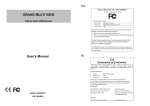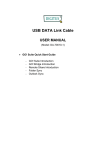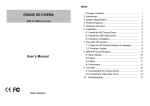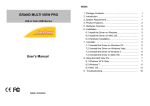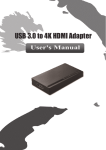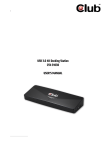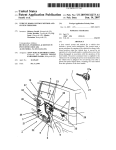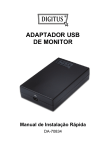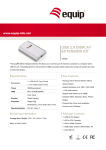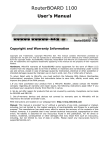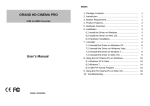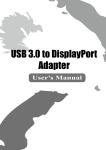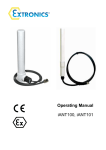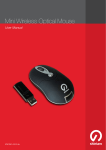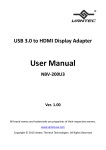Download USB 3.0 Single/Dual Display Docking Station
Transcript
USB 3.0 Single/Dual Display Docking Station User's Manual Table of contents Safety instructions ...........................................................1 Copyright...........................................................................1 Trademarks .......................................................................1 Introduction.......................................................................2 Features.............................................................................2 Package contents .............................................................2 System requirements .......................................................3 Product overview................................................ ..............4 - Front ..................................................................................4 - Rear...................................................................................5 Connection..........................................................................6 - Dual display docking station..............................................6 - Single display docking station ...........................................7 Installation ........................................................................ 8 - For Windows® 7/ Windows® 8 user ..................................8 - For Windows® Vista user .................................................11 - For Windows® XP user ....................................................13 Verifying the driver……………………………………. ….. 14 Display configuration....................................................... 15 - Utility settings .....................................................................15 - Multi-monitor configuration .................................................18 Audio configuration ......................................................... 23 Uninstall the driver ........................................................... 24 - For Windows® 7/ Windows® 8 user …..............................25 - For Windows Vista® user ...................................................26 - For Windows XP® user ......................................................27 Specification ........................................................................28 Regulatory compliance ..................................................... 29 - FCC conditions................................................................... 29 - CE ..................................................................................... 29 - WEEE information .............................................................. 29 Before attempting to connect, operate or adjust this product, please save and read the User's Manual completely. The style of the product shown in this User's Manual may be different from the actual unit due to various models. Safety instructions Always read the safety instructions carefully: ■ Keep this User’s Manual for future reference ■ Keep this equipment away from humidity ■ If any of the following situation arises, get the equipment checked by a service technician: • The equipment has been exposed to moisture. • The equipment has been dropped and damaged. • The equipment has obvious sign of breakage. • The equipment has not been working well or cannot get it to work according to the User’s Manual. Copyright This document contains proprietary information protected by copyright. All right are reserved. No part of this manual may be reproduced by any mechanical, electronic or other means, in any form, without prior written permission of the manufacturer. Trademarks All trademarks and registered trademarks are the property of their respective owners or companies. 1 Introduction The Shintaro Blazer Docking Station is a unique design for a computer that has extra connectivity demands. Through the docking station, you can extend the connection of a computer to more USB peripherals, Ethernet network, speaker and microphone using only one USB port on your computer. This docking station is built-in USB 3.0 ports which mean you can enjoy the super speed data transmission between USB peripherals. Besides, this product is fully compliant with the USB 1.1/2.0 specification. Your previous USB 1.1/2.0 devices can continue to function as usually. The video output is another feature. With the DVI (and HDMI® Dual Head Docking Station model only) port(s), you can connect more monitor, LCD or projector. The connected monitor can be configured to either mirror your primary screen, or extend the Window desktop allowing visibility of more applications at the same time. No more stacking windows within the confines of a single display. As to the housing, aside from the impressive sailboat-like appearance, the upright design of the body helps to spare your desktop space. Most peripherals are connected behind while two USB ports and audio outputs are implemented on the front panel for easier accessibility. An industry standard security lock is also provided for anti-theft purpose. Enhanced expansion capability plus the stylish appearance, surely this docking station with video is the most versatile accessory that also complements your home or office space. Features ■ Compatible with USB 3.0/2.0 specification ■ Resolution up to 2048x1152 ■ Support audio 2.1 channel ■ Support Gigabit Ethernet ■ Support HDMI® 1.3 (Dual Display Model only) Package contents ■ Docking Station x1 ■ USB 3.0 Cable x1 ■ Power Adapter x1 ■ CD (Driver and User’s Manual) x1 ■ Quick Installation Guide x1 2 System requirements The minimum requirements for the PC are: ■ 1.6 single core CPU or higher processor clock. Intel Pentium/Celeron family, or AMD K6/Athlon/Duron family, or compatible processor ■ 1GB of RAM ■ USB 2.0/3.0 port ■ 30MB of available disk space ■ Windows® XP 32-bit,Windows® Vista 32/64-bit,Windows® 7 32/64bit, Windows® 8 32/64bit. To play DVD on the extra connected monitor through docking station, in addition to the requirements above, the following requirements should also be met: ■ With dual core CPU at 2.0 GHz processor clock 3 Product overview Front 1 2 3 4 5 1 Power indicator: Lights up when the power is on. 2 USB indicator: Lights up when a USB device is plugged into this unit. 3 USB 3.0 ports: Connect to USB 3.0 devices. 4 Speaker jack: Connect to a speaker or earphone. 5 MIC jack: Connect to a microphone. 4 Rear Dual Display Docking station Single Display Docking Station 6 6 7 7 8 8 9 10 10 11 11 6 USB 2.0 ports: Connect to USB 2.0 devices. 7 RJ45 port: Connect to an Ethernet. 8 DVI connector: Connect to a DVI monitor or projector. 9 HDMI connector: Connect to a HDMI monitor or projector. Note: This function provided only on the model of Dual Head Docking Station. 10 USB 3.0 port (Type B): Connect to a computer. 11 Power jack: Connect to the power adapter. 5 Connection To connect the USB peripherals, Ethernet, speaker and microphone, follow the illustrations below to connect the corresponding connectors. Dual display docking station Router Monitor USB peripherals PC Power adapter Earphone Microphone 6 Single display docking station Router USB peripherals PC Power adapter Earphone Microphone 7 Installation Caution: DO NOT connect the docking to a computer before installing the provided driver. Note that the following strings and screen shots shown on this user's manual may vary slightly from each operation. For Windows® 7/ Windows® 8 user 1.Insert the supplied driver CD into a computer's CD/DVD- ROM. 2. Click <Run Setup.exe> to start the installation. 8 Note: If the AutoPlay does not appear automatically, locate and double-click on the Setup.exe file in the driver folder to launch the setup. Enter the administrator password and then click <Yes> to start the installation if a User Account Control dialog box appears. 3. Click <I Accept> for the next step. 9 4. Be patient with the installation procedure, it may take a while. 5. Connect the Docking Station to a computer after the driver installation is completed. For connection details, refer to the chapter of Connection. 6. When the operating system detects the adapter, the reminder message will appear on the system tray as below. 10 For Windows® Vista user 1. Insert the supplied driver CD into a computer's CD/DVD- ROM. 2. Click <Run Setup.exe> to start the installation. Note: ● If the AutoPlay does not appear automatically, locate and double-click on the Setup.exe file in the driver folder to launch the setup. ● Enter the administrator password and then click <Allow> to start the installation if a User Account Control dialog box appears. 3. Click <I Accept> for the next step. 11 4. Be patient with the installation procedure, it may take a while. 5. Connect the Docking Station to a computer after the driver installation is completed. For connection details, refer to the chapter of Connection. 6. When the operating system detects the adapter, the reminder message will appear in the Windows System Tray as below. 12 For Windows® XP user 1. Insert the supplied driver CD into a computer's CD/DVD- ROM. 2. Click <I Accept > for the next step. 3. Be patient with the installation procedure, it may take a while. Note: Click <Yes> to restart or <No> to manually restart later, if a prompting to restart computer message appears. 4. Connect the Docking Station to a computer after the driver installation is completed. For connection details, refer to the chapter of Connection. 13 Verifying the driver To verify the driver of the adapter, follow the step below to open the Device Manager on Windows operating system. 1. Following the path as below to open the device manager Windows® 7/Windows® 8: Control Panel\System and Security\ System\Device Manager Windows® Vista: Control Panel\System Maintenance\Device Manager Windows® XP: Control Panel\System\Hardware\Device Manager 2. A string similar to DisplayLink.. Adapter device should be listed. Docking Station Dual Head Station The screen shot above is demonstrated by Windows® 7 and might be varied slightly for each operation system. Note: If there is a (question) or (exclamation) mark next to that item, then the driver is not properly installed. Please delete the item, unplug the adapter and repeat the installation steps. 14 Display configuration Note that the following screen shots in this section are using Windows® 7 operating system. It may not match your operating system but the definitions of buttons, tabs and menus are the same. Utility settings The supplied utility allows configuring the display mode, screen rotation, screen resolution, and physical arrangement of your monitors. 1. Click < (utility icon) > in the Windows System Tray. Note: The may be hided in the Windows System Tray. Click < bring up more icons if it happens. 2. Select a preferred option, and then click it using mouse. 15 (arrow icon) > to Description of the settings Option Description Displaylink manager Enable the Windows screen resolution page. Check for updates Check the latest driver and download if available USB3.0 Video Dock/Dual Head Video Dock(*The actual item is depending on the model) Screen Resolution Click to select an available resolution. Note that this function is invalid in mirror mode, as the resolution is defined as the resolution of the primary monitor Screen Rotation Rotate the screen according to the desired orientation Extend Extend the screen according to the desired orientation Extend to The cursor can extend to desired screen via left/right/above/below way moving Set as Main Monitor Set this screen to the main screen Notebook Monitor Off Switch the add-on monitor to the main display and turn off the screen of the laptop. Note:This function works only when one add-on monitor is connected. This option will also only appear on laptop. Mirror Duplicate the primary monitor to the monitor which connects with the adapter Off Turn off the monitor Optimize for video Optimize the video quality when playing back. Text may appear less clear when enabling 16 Options Description USB 3.0 Video Dock/Dual Head Video Dock (* The actual item is depending on the model) Fit to TV Adjust the size of Windows Desktop on the TV Note: This function works only when one add-on monitor is connected. Besides, this option will also only work in extended mode. The add-on monitor will change to the extended mode if selecting this option while in mirror mode. Audio Setup Enable the Windows audio configuration page. This function works only in specific models. Video Setup Enable the Windows screen resolution page. 17 Multi-monitor configuration An extra DVI monitor can be connected through the Docking Station (HDMI® and DVI monitors for Dual Head Station) if one monitor is already connected to the PC directly. Once the extra monitor is connected, it can be configured to use either “mirror mode”, “extended mode” or be the primary display. Position the mouse anywhere on the Windows Desktop, right-click and select <Screen Resolution> on Windows® 7/ Windows® 8, Personalize > Display Settings on Windows® Vista or Properties > Settings on Windows® XP. Docking Station Dual Head Station Alternatively, click < (utility icon) > in the Windows System Tray, and then select DisplayLink Manager or Video Setup. 18 Extended mode 1. Refer to the Windows system configuration section to open the configuration page. 2. In the Display drop-down menu, select the preferred monitor. 2 3 2 3 4 4 3. Check the Multiple Displays > Extend these displays on Window® 7/ Window® 8, Extend the desktop onto this monitor box on Windows® Vista or Extend my Windows desktop onto this monitor box on Windows® XP. 4. Click <OK> to confirm and close the settings screen. 5. Once the setting is completed, simply drag and drop the application icons or the opened windows to the add-on monitor. However, some applications may not support to display on the extended desktop. 19 Cursor disappeared If the status remains in the extended mode but the adapter is disconnected, the desktop will still be panned to the add- on monitor. The cursor may not be found on the primary monitor in such a case. If it happens, connect the addon monitor through the adapter again or keep moving the mouse. Video playback in extended mode If the video or DVD playback quality is poor or low performance in the extended mode, please playback it on the primary monitor instead of the add-on monitor. Mirror mode 1. Refer to the Windows system configuration section to open the configuration page. 2. In the Display drop-down menu, select the preferred monitor. 3. Check the Multiple Displays > Duplicate these displays on Window® 7\ Window® 8, uncheck the Extend the desktop onto this monitor box on Windows® Vista or Extend my Windows desktop onto this monitor box on Windows® XP/ Windows® 2000. 4. Click <OK> to confirm and close the settings screen. 20 Be the primary monitor 1. Refer to the Windows system configuration section to open the configuration page. 2. In the Display drop-down menu, select the preferred monitor. 3. Check the Make this my main display box on Window® 7 /Windows® Vista, Set as Main Monitor on Windows® 8 or Use this device as the primary monitor box on Windows® XP. Note: Some PCs and laptops may need to disable the main display (i.e. uncheck the Extend the desktop onto this monitor or Extend my Windows desktop onto this monitor box for the main display) as part of the same settings change. 4. Click <OK> to confirm and close the settings screen. Windows shortcut Press < (Windows) > + <P> button to bring up the menu as below, and then select a desired option. This function is available for Windows® 7 only. 21 Supported resolution Before adjusting the resolution, refer to the table below for the supported resolution. Name 640x480 800x600 1024x768 1280x720 1280x768 1280x800 1280x1024 1366x768 1400x1050 1600x1200 1680x1050 1920x1080 1920x1200 2048x1152 VGA SVGA XGA 720p WXGA+ WXGA SXGA WXGA+ SXGA+ UXGA WSXGA+ 1080p WUXGA QXGA Refresh rate 16 bit 60 72 75 85 56 60 72 75 85 60 70 75 85 60 60 70 75 85 5885 60 60 75 85 60 60 75 85 60 60 60 60 60 Refresh rate 32 bit 60 72 75 85 56 60 72 75 85 60 70 75 85 60 60 70 75 85 60 60 75 60 60 75 85 60 60 60 60 60 Note that interlaced modes and reduced blanking modes are not supported. 22 Audio configuration By default, when the docking station is connected to a computer, the audio configuration may be changed to USB (Multimedia) Audio Device automatically (this setting depends on models). If it does not work, follow the steps below to setup. For Widnows® 8 user 1. Open Control Panel and then select the hardware and sound icon 2. Click Sound->Manage audio devices and then select Displaylink Audio For Widnows® 7 user 1. Open Control Panel and then select the sound or audio icon. 2. Click Playback tab, and then select USB Audio Device or Displaylink Audio 23 For Widnows® XP user 1. Click the DisplayLink icon to bring up the DisplayLink Manager on the Windows System Tray, and then select Audion Setup. 2. Click Audio tab, and then select USB Audio Device or DisplayLink Audio on the Sound playback option. 3. Repeat the step 2 on the Sound recording option. 2 3 24 Uninstall the driver For Windows® 7/ Windows® 8 user 1. Open the Control Panel > Programs > Programs and Features > Uninstall or change the program, and then double click <DisplayLink Graphics>. 2. Click <Yes> to continue the procedure. 3. Click <Yes> to restart your computer. 25 For Windows® Vista user 1. Open the Control Panel > Programs > Programs and Features > Uninstall or change the program, and then double click <DisplayLink Graphics>. 2. Click <Yes> to continue the procedure. 3. Click <Yes> to restart your computer. 26 For Windows® XP user 1. Open the Control Panel > Programs > Programs and Features > Uninstall or change the program, and then double click <DisplayLink Graphics>. 2. Click <Yes> to continue the procedure. 3. Click <Yes> to restart your computer. 27 Specification Host Interface USB 3.0 Connector Video output HDMI® 30pin Female Connector (Dual Display model) DVI HDDE 30pin Female Connector Host upstream link USB B Type Female Connector HUB downstream link USB A Type Female Connector Audio Port 3.5mm stereo mini-jack 2.1ch Ethernet Port RJ45 Connector Power DC power jack Video resolution HDMI (Dual Display model) 2048x1152 DVI 2048x1152 Supported colors 16 Bits and 32 Bits Audio 2.1Ch Ethernet 10/100/1000 Power Power Mode Self-powered Power Adapter Input: AC 100-240V Physical Properties Working Environment Compliance Output: DC 5V/4A Power Consumption Operating Power: 14.43W Suspend Mode Power: 1.95W Housing ABS (Plastic) Weight 365g approx. Operation Temperature 0~40 degree Storage Temperature -20~70 degree CE,FCC 28 Regulatory compliance FCC conditions This equipment has been tested and found to comply with Part 15 Class B of the FCC Rules. Operation is subject to the following two conditions: (1) This device may not cause harmful interference (2) This device must accept any interference received and include interference that may cause undesired operation. CE This equipment is in compliance with the requirements of the following regulations: EN 55 022: CLASS B WEEE information For EU (European Union) member users: According to the WEEE (Waste electrical and electronic equipment) Directive, do not dispose of this product as household waste or commercial waste. Waste electrical and electronic equipment should be appropriately collected and recycled as required by practices established for your country. For information on recycling of this product, please contact your local authorities, your household waste disposal service or the shop where you purchased the product. Shintaro Blazer Docking Station User's Manual 29

































